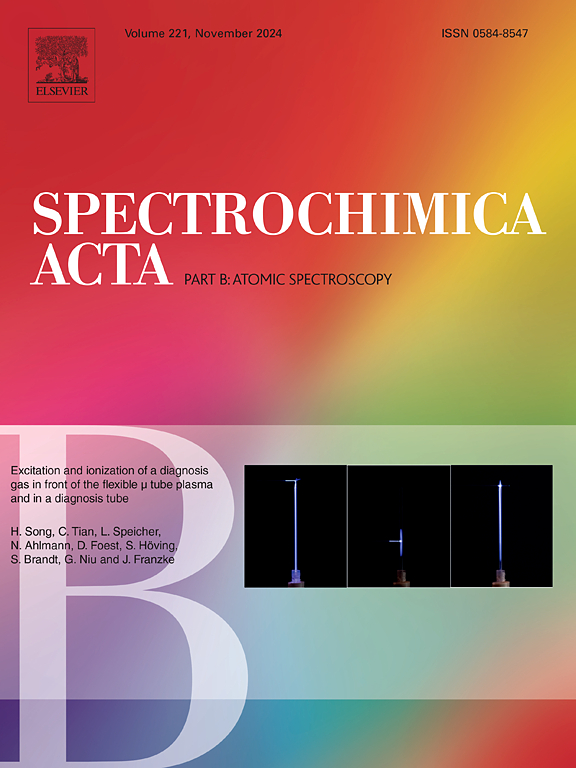Surface and in-depth characterization of commercial papers by LIBS technique: Parameters and features for their classification, and complementary information from Raman spectroscopy
IF 3.2
2区 化学
Q1 SPECTROSCOPY
引用次数: 0
Abstract
In examination of documents by LIBS technique, the paper material is usually probed by surface scanning and the averaged spectra are processed by chemometric methods. The scope of this work is to have insight into LIBS analysis of common writing/printing papers, considering both the laser depth profiling and surface measurements. The sample set consisted in 14 papers (copy, notebook and envelope papers), some of them made of recycled materials. Examination of the laser induced craters showed a preferential ablation of paper fillers while the cellulose fibres were displaced at surface and swallowed around the centre of laser spot. Beside material inclusions, found both on the paper surface and in depth, the not uniform ablation also contributes to large intensity fluctuations of the element's line intensities, which standard deviations differ from one sample to another. By studying correlations between the line intensities from different elements at paper surface and in depth, it was possible to distinguish some top coatings (e.g., kaolinite) from bulk fillers (e.g., containing alumina-silicates), to hypothesize the use of NaOH in the industrial processing, as well as to exclude presence of certain types of fillers or coatings. Raman spectroscopy was performed both on sample surfaces and inside the laser induced craters (bulk material), showing the differences among papers regarding relative contents of CaCO3 filler, lignin, and cellulose. We tested different chemometric models based on the LIBS measured composition of paper bulk or surface, obtaining up to 100 % correct classification for six similar copy papers of Italian manufacture.

利用LIBS技术对商业纸张进行表面和深度表征:分类的参数和特征,以及来自拉曼光谱的补充信息
在利用LIBS技术检测文件时,纸张材料通常采用表面扫描探测,平均光谱采用化学计量学方法处理。这项工作的范围是深入了解普通书写/印刷纸张的LIBS分析,同时考虑激光深度轮廓和表面测量。样本包括14张纸(复印纸、笔记本纸和信封纸),其中一些是用回收材料制成的。激光诱导凹坑的检查显示,纸张填料优先消融,而纤维素纤维在表面移位并在激光光斑中心周围被吞噬。除了在纸面和纸面深处都存在材料夹杂物外,烧蚀不均匀也导致了元素线强度的大强度波动,其标准差因样品而异。通过研究纸张表面和深度不同元素的线强度之间的相关性,可以区分一些顶部涂层(例如,高岭石)和大量填料(例如,含有铝硅酸盐),假设在工业加工中使用NaOH,以及排除某些类型的填料或涂层的存在。在样品表面和激光诱导陨石坑(块状材料)内部进行拉曼光谱分析,显示了CaCO3填料、木质素和纤维素的相对含量在论文之间的差异。基于LIBS测量的纸张体积或表面成分,我们测试了不同的化学计量模型,对意大利制造的六种类似的复印纸进行了高达100%的正确分类。
本文章由计算机程序翻译,如有差异,请以英文原文为准。
求助全文
约1分钟内获得全文
求助全文
来源期刊
CiteScore
6.10
自引率
12.10%
发文量
173
审稿时长
81 days
期刊介绍:
Spectrochimica Acta Part B: Atomic Spectroscopy, is intended for the rapid publication of both original work and reviews in the following fields:
Atomic Emission (AES), Atomic Absorption (AAS) and Atomic Fluorescence (AFS) spectroscopy;
Mass Spectrometry (MS) for inorganic analysis covering Spark Source (SS-MS), Inductively Coupled Plasma (ICP-MS), Glow Discharge (GD-MS), and Secondary Ion Mass Spectrometry (SIMS).
Laser induced atomic spectroscopy for inorganic analysis, including non-linear optical laser spectroscopy, covering Laser Enhanced Ionization (LEI), Laser Induced Fluorescence (LIF), Resonance Ionization Spectroscopy (RIS) and Resonance Ionization Mass Spectrometry (RIMS); Laser Induced Breakdown Spectroscopy (LIBS); Cavity Ringdown Spectroscopy (CRDS), Laser Ablation Inductively Coupled Plasma Atomic Emission Spectroscopy (LA-ICP-AES) and Laser Ablation Inductively Coupled Plasma Mass Spectrometry (LA-ICP-MS).
X-ray spectrometry, X-ray Optics and Microanalysis, including X-ray fluorescence spectrometry (XRF) and related techniques, in particular Total-reflection X-ray Fluorescence Spectrometry (TXRF), and Synchrotron Radiation-excited Total reflection XRF (SR-TXRF).
Manuscripts dealing with (i) fundamentals, (ii) methodology development, (iii)instrumentation, and (iv) applications, can be submitted for publication.

 求助内容:
求助内容: 应助结果提醒方式:
应助结果提醒方式:


